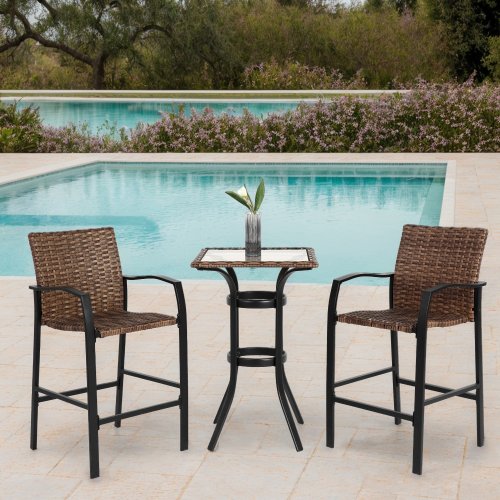Outdoor furniture must withstand diverse environmental challenges—from scorching sun and heavy rain to salty sea breezes and freezing temperatures. Choosing the right material isn’t just about aesthetics; it’s a science-driven decision balancing durability, maintenance, and climate compatibility. This guide breaks down the 5 core categories of outdoor furniture materials, their sub-varieties, and optimal geographic applications, empowering you to make informed choices for any project.
1. Metals: Strength Meets Modern Design
Primary Types:
- Aluminum (Powder-Coated / Anodized)
- Stainless Steel (Marine-Grade 316)
- Wrought Iron (Galvanized / Painted)
Aluminum:
- Best For: Coastal regions, humid climates
- Why: Naturally rust-resistant, lightweight (ideal for modular designs).
- Key Variants:
- Powder-Coated Aluminum: Extra UV protection for desert/Mediterranean zones.
- Anodized Aluminum: Electrochemical finish resists salt corrosion (ideal for beachfront properties).
Stainless Steel:
- Best For: High-end commercial spaces, snowy climates
- Why: Withstands freeze-thaw cycles; marine-grade 316 resists pitting in saltwater.
- Pro Tip: Pair with slatted designs to prevent water pooling.
Wrought Iron:
- Best For: Low-maintenance dry climates (e.g., Arizona, Middle East)
- Caution: Requires annual anti-rust treatments in humid areas.

2. Woods: Natural Beauty with Climate-Specific Treatments
Primary Types:
- Teak
- Cedar
- Eucalyptus
- Acacia
Teak:
- Best For: Tropical & temperate zones
- Why: Natural oils repel water/insects; ages to silver patina.
- Regional Tip: Use kiln-dried teak in rainy climates to minimize warping.
Cedar:
- Best For: Mountainous/cooler regions (e.g., Canada, Alps)
- Why: Resists rot in damp conditions; lightweight for movable furniture.
Acacia:
- Best For: Budget-conscious projects in arid/semi-arid climates
- Caution: Prone to cracking in high-humidity zones without sealants.

3. Synthetics: Innovation for Extreme Conditions
Primary Types:
- PE Rattan/Wicker
- HDPE Lumber
- Polypropylene (Textilene)
PE Rattan:
- Best For: Poolside (tropical/coastal areas)
- Why: UV-stabilized polyethylene resorts fade; molds to ergonomic shapes.
- Upgrade Option: Add aluminum cores for hurricane-prone regions.
HDPE Lumber:
- Best For: High-traffic public spaces (parks, boardwalks)
- Why: Immune to rot/insects; withstands -40°C to 60°C.
Textilene:
- Best For: Cushions in rainy climates
- Why: Breathable mesh dries 3x faster than standard fabrics.

4. Stone & Concrete: Luxury for Stable Climates
Primary Types:
- Granite
- Slate
- Reinforced Concrete
Granite:
- Best For: Mediterranean/desert landscapes
- Why: Heat-resistant; stays cool in shade. Avoid in freeze-thaw regions.
Reinforced Concrete:
- Best For: Permanent urban installations
- Innovation: Fiberglass-reinforced versions reduce cracking risk.
5. Hybrid Materials: Custom Solutions
Combine materials to address regional challenges:
- Teak + Stainless Steel: Marine environments (e.g., yachts, Maldives resorts)
- HDPE + Aluminum: High-wind areas (e.g., Caribbean rooftops)
Geographic Material Guide
| Climate Zone | Top Materials | Avoid |
|---|---|---|
| Tropical Humid | PE Rattan, Anodized Aluminum | Untreated Wood, Iron |
| Arid/Desert | Powder-Coated Metals, Granite | Natural Wicker |
| Coastal | Marine-Grade Steel, HDPE | Mild Steel, Cedar |
| Continental Cold | Stainless Steel, HDPE Lumber | Concrete, Thin Aluminum |
